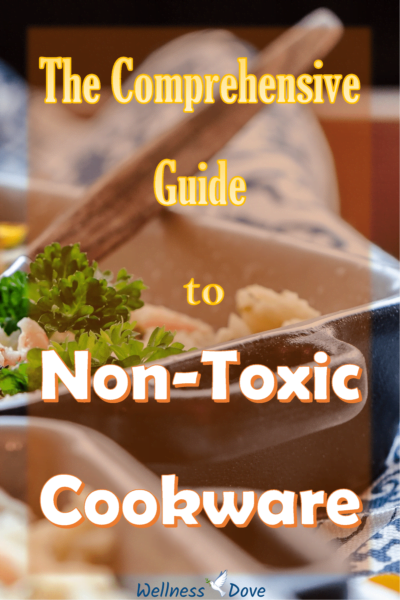
Cooking is that uniquely human invention that allows us to pack a lot of nutrition into a single meal.
Food is instrumental for our health and for said food to be healthy, we need to make sure that it is not compromised by very utilities we use to cook it.
We can choose from a wide variety of cookware today. And since you are here, you probably know that much of it may be contaminating your food.
Our aim with this article is to provide you with the best information and advice about how to choose the cookware which keeps you healthy!
Cookware that is safe
Enamelled Iron & Steel
Enamelled cookware is basically coating iron or steel cookware with powdered glass.
In other words, enameled cookware is one of the safest options out there.
Add to that that it is durable, easy to clean and food does not stick that much.
Make sure that you buy it from a reputable source so that it is not made with toxic metals such as lead.
It can get quite pricey as an 11-3/4-Inch Skillet or an Enamelled Cast Iron Baking Dish can top $200.
If you want great, healthy cookware that will last you years to come, though, enameled cast iron is a way to go.
Glass cookware
The glass is probably the most natural and purest of all materials. Probably.
Chemically unaltered in any way, it is, in essence, filtered sand. It does not leach toxins into our food and glass cookware.
That is true for simple white glass, though. The fancier glassware that is colored or “crystal” can contain lead, which is toxic.
The simpler options though are healthy, inexpensive and versatile. A Pyrex 5 Piece Bakeware can double as a storage container or can be used in the freezer.
Ceramic cookware
Ceramic cookware is in its basic form sand or stone that has been fire hardened.
Make sure that you buy from a reputable source so that it does not have lead in it. Xtrema and Ozeri are an exaple for a good buy.
Since sand and stone are relatively inert, good quality ceramic cookware is one of the healthier options out there.
Ceramic or ceramic coated
Ceramic cookware means that your pan or pot is made entirely from ceramic.
This option is more expensive than ceramic coated cookware but the quality is higher as well.
It should be noted, though, that ceramic cookware does not mean non-stick cookware.
Companies such as Xtrema are popular for their ceramic cookware.
Ceramic coated cookware is cookware that is made, in most cases, from aluminum, coated with a ceramic layer.
There are a number of benefits for choosing a “ceramic coated”:
- generally non-stick.
- cheaper;
- healthier;
- the aluminum base is a better heat conductor;
- lighter;
- the ceramic coating can be quite durable.
Choose a reputable manufacturer, though!
Ceramic coating may suggest non-toxic materials, however, some cheaper brands will add potentially hazardous additives such as lead or cadmium.
Go for reputable brands such as Ozeri, that use high-quality coatings such as German-made Greblon®.
Also, if your ceramic coated cookware is damaged, consider replacing it. The aluminum core, for example, could become exposed and seek toxic aluminum into your food.
Cookware that is sort-of safe
Stainless Steel
Stainless steel is an alloy.
And an alloy means that there are various metals in its composition. Iron, carbon, chromium, and nickel are the main components.
A study found that stainless steel cookware can leach chromium into the food and the same is most likely true for iron.
Chromium and nickel are considered to be a cause for allergic contact dermatitis. Iron can cause hypothyroidism in high quantities.
That said, in general, steel is considered to be relatively inert and does not react that much with the food. And a durable, beautiful and inexpensive one too.
Compared to really toxic materials such as aluminum, it is probably OK to use steel cookware.
Cast Iron
Cast iron cookware can be considered healthy. With a caveat, though.
Cast iron means cookware means cookware made out of iron.
And iron is good for you, right?
Not always, though. Too little iron and you can suffer from hyperthyroid problems. Too much… and you suffer from hypothyroid problems.
And it is known that the iron from your cast iron pan will leach into your food.
That is why if you plan to use your cast iron pan a lot, go for enameled cast iron.
If you need a not-so-expensive cookware that you will use infrequently but will last, cast iron is a good way to go.
Lodge cast iron cookware is a good choice in terms of quality and price.
Cookware to avoid
Synthetic non-stick coatings
There is a lot to say about synthetic coatings such as Teflon.
And there is nothing much to say about them as well.
They are synthetic, full of untested for their safety chemicals. It means “Avoid if possible” for us.
And it is possible. And we avoid them.
Aluminum
Aluminum is a neurotoxin.
It is used in vaccines in tiny quantities to put the immune system on alert.
Studies suggest that it can do all sorts of damage, including cause diseases such as Alzheimer’s.
Why do we need to take the risk of cooking in it and ingesting it?
Copper
It is toxic. Period.


